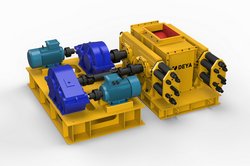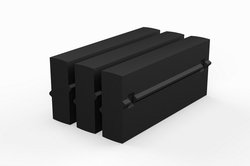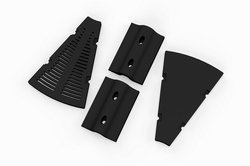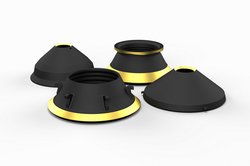Comprehensive explanation about roll crushers
Introduction
Roll crushers are used for primary as well as secondary and tertiary stages. They are used for crushing lignite, coke, coal, soft to medium-hard rock, ore, iron ore and similar products.
Roll crushers are of two types: single roll crusher and double roll crusher.
Single roll crushers are typically used as primary crushers. Double roll crusher are typically used in situations in which fines are to be minimized.
Single Roll Crushers
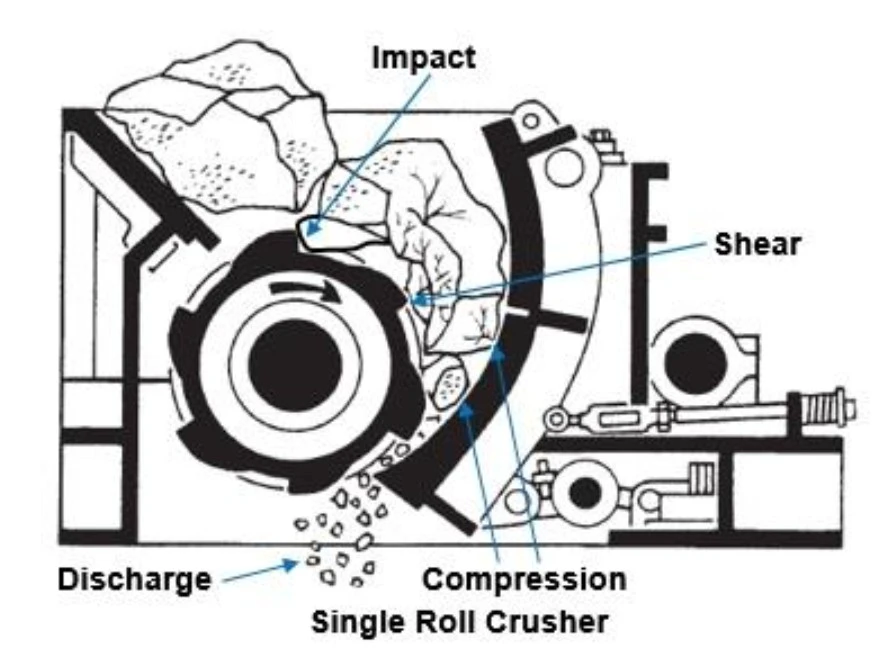
As shown in above figure, a single roll crusher consists of a roll assembly and a breaker plate. In these crushers, reduction occur due to impact, shear and compression.
As shown in the following figure, sometimes, comb teeth-like projections are provided at bottom of the breaker plate, which are duly hard-faced by special electrodes of wear-resistant quality.
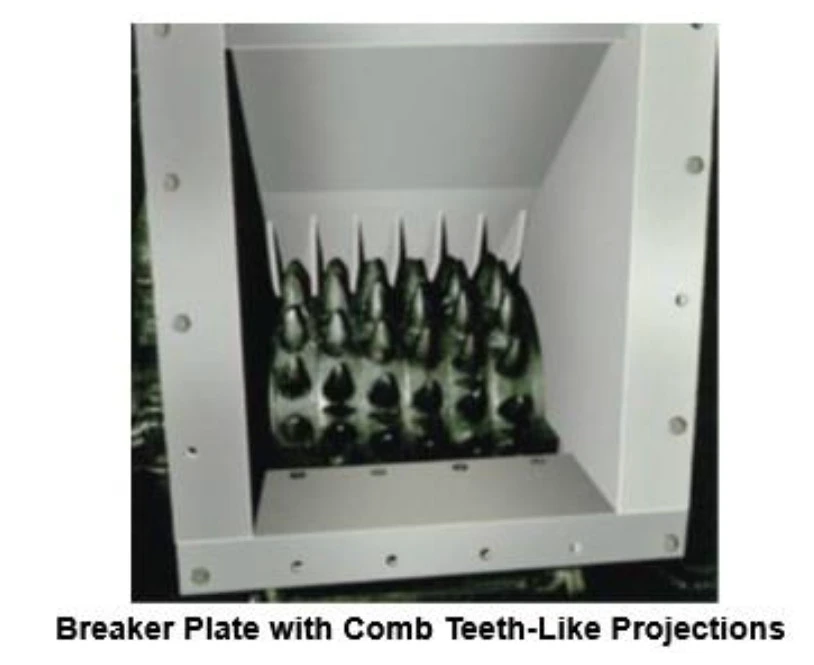
As material enters the crusher through the feeder hopper, it is struck by the teeth of the revolving roll and initial breakage occurs from the impact.
The rotation of the roll then guides the material further into the crushing chamber, the space between the breaker plate and the roll itself.
The roll then pinches the material against the stationary breaker plate, and simultaneously, the material is crushed by the shearing action of the roll teeth and by compression, providing final sizing.
The crushed material exits through the bottom discharge portion of the crusher.
The gap between the bottom lip of the breaker plate and the rotating roll determines output size of the product. The output size of the product is adjusted by changing the size of the gap.
This gap is adjustable from outside the machine by a shim (or spindle) arrangement. Adding or removing shims (or rotating the spindle) causes the breaker plate to pivot about its top hinge, moving it into or away from the roll.
For protection against uncrushable debris (tramp iron), the breaker plate assembly is secured with an automatic release device.
As pressure from the uncrushable is exerted against the plate, the device allows the entire breaker plate assembly to move away from the roll instantly.
The uncrushable drops clear of the machine by gravity, and the breaker plate assembly immediately returns to its normal crushing position.
Many times crushers are also provided with shear pin and zero speed switch as additional safety device.
Double Roll Crushers
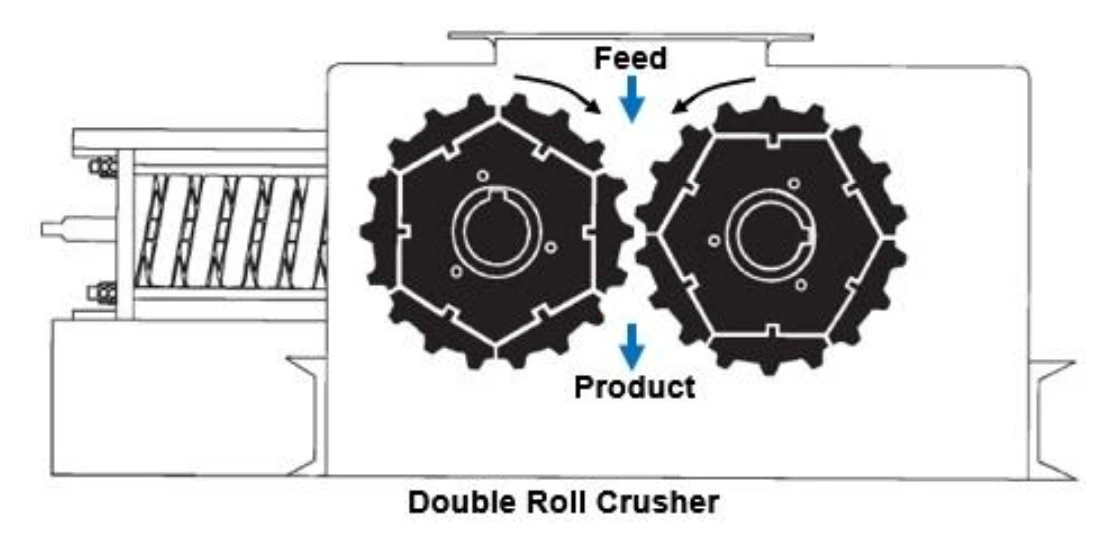
As shown in above figure, a double roll crusher consists of two parallel rotating rolls turning together (in opposite directions and turning in the direction of the downward material flow through the centre), with feed being directed through the moving gap between them. The rolls are individually powered or coupled by gears.
The crushing material is fed into the crusher such that it is spread over the whole width of the rollers. As the two rolls rotate toward each other, the material is pulled down into the crushing zone where it is grabbed and compressed by the rolls. Since both rolls rotate at the same speed, there is no relative motion between the two roll surfaces, and crushing is primarily accomplished by compression. Fines are reduced because already sized material passes freely through the crusher with no further reduction.
Product size is determined by the size of the gap between the rolls, and this gap can be changed to vary product size or to compensate for wear. To change the gap, one of the two crushing rolls is designed as a loose roll. The gap adjustment is done mechanically, hydraulically or electro-mechanically.
Protection from uncrushable debris (tramp iron), is provided by the loose/retractable roll assembly. It retracts instantly when an uncrushable is encountered, then reverts to its original position once the uncrushable has cleared the crushing chamber with no stoppage of the crusher.
Double roll crushers are well suited for extremely hard and abrasive materials.
Construction Details
Housing/Frame
Housing/Frame is generally fabricated from structural steel plates and heavy section duly stiffened by ribs. Replaceable wear resistant steel liner plates are fitted at the crushing zones.
Rotor Assembly
The rotor assembly is fitted with smooth or toothed circular crushing rings or segments to suit individual application. The following figure shows some common roll tooth patterns.

In double roll crushers, smooth rolls are used for crushing medium hard to hard materials whereas toothed rolls are used to crush soft to moderately hard materials.
The wear parts, toothed circular crushing rings or segments and breaker plate are made of manganese steel or wear resistant steel.
Hybrid Crushers
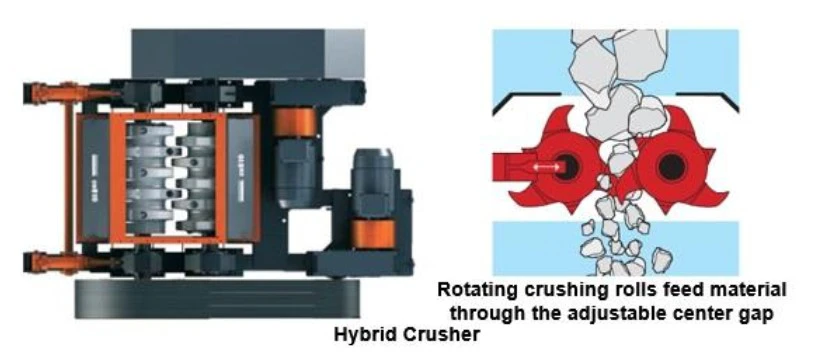
As shown in above figure, a hybrid crusher results in a compact design as a result of aggressive tooth geometry. Hybrids are used for primary and secondary crushing of soft and medium hard materials that also have the tendency to be wet and sticky.
They are equipped with an advanced hydraulic gap adjustment system with integrated overload protection to realize different product sizes and to protect the machine against foreign bodies within the feed material. Furthermore, the hybrid is able to compensate peaks with “energy storage” in the flywheels.
Crusher Feeding
Once the crusher reaches operating speed, it may be choke-fed from hoppers or fed at continuous, controlled rates from vibratory screens, apron feeders or belts.
Low Speed Sizers
A low speed sizer is designed to accept feed material (either ROM, i.e. for primary crushing or pre crushed, i.e. secondary crushing applications) through the top of the crushing chamber, drawing it through the rotating shafts laced with teeth (rolls) and crushing or sizing it to a specified product size.
Low speed sizers are insensitive to clay and sticky materials. Dust and noise generation are also low due to low roll speed. As low speed sizers allow high throughput capacities to be achieved with a compact machine design, plant dimensions can
be significantly reduced, ensuring low investment costs.
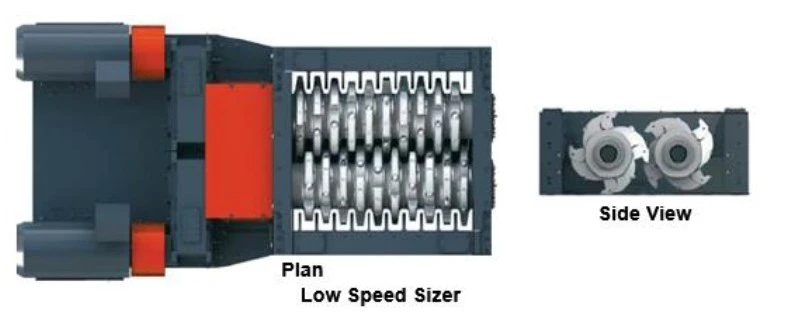
Above figure shows typical construction of a low speed sizer. As shown in the figure, in a low speed sizer, two toothed rolls revolve in a chamber at low speeds and high torque. The shear and tensile forces required for crushing or sizing are generated by the high rotor torques at low circumferential speeds.
The low speed of the crushing rolls results in low fines content in the final product. Furthermore, low roll speeds maximize wear life of consumable elements due to positive bite and minimal feed slip.
As per one of the leading manufacturer, the actual rotating tip speed of the tooth or sizing element in a sizer can be as low as 0.8 m per second (primary applications) and up to 1.8 m per second (tertiary & quaternary applications).
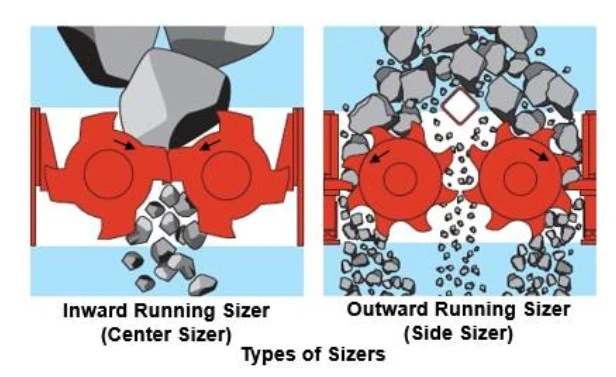
As shown in above figure, there are two types of sizers: inward running sizer or center sizer (rolls rotating in the inward direction) and outward running sizer or side sizer (rolls rotating in the outward direction). Inward running is the normal method of operation for most tooth configurations and must be used on wet sticky materials.
For secondary and tertiary applications, outward running sizer can be used on certain materials to produce a smaller
product than is possible with inward running sizer. In the outward running sizers, the material gets crushed between the roll and the side/lateral crushing comb.
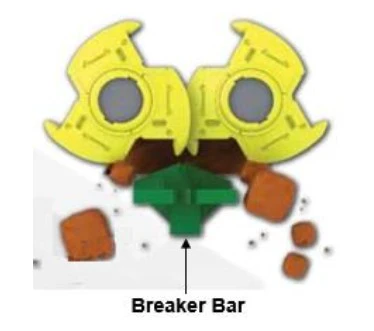
As shown in above figure, many times a breaker bar is provided in the inward running sizers or center sizers. The breaker bar is used to break any lumps of material that still remains oversized after the feed material has passed the rolls. Lumps are broken as the rotors chop through the fixed teeth of the breaker bar.
As there is no impact that will cause the material to pack in the crushing chamber, the low speed sizers are the only primary crushers that can handle the sticky materials effortlessly.
In most cases, pre-screening (pre-scalping) of undersize material is not necessary, as the fines contained in the feed material can pass smoothly through the crushing rolls.
Low speed sizers are protected against overload or from foreign particles contained in the feed material (tramp iron) by providing under speed sensors (proximity probe) for autoreverse operation or discharge to by-pass chutes (provided with hydraulically operated doors) so that they will not suffer catastrophic damage.
In case of drives with fluid couplings, thermal overload switch if provided or fusible plug on the fluid coupling also provides protection against overload or from tramp iron.
Construction Details
Generally, the main frame (housing) is fully fabricated and machined from carbon steel plates. Wear plates are used to completely cover the sizing/crushing chamber (the inside of the housing).

The rolls consist of the bearings and shafts, which are fitted with easily replaceable crushing segments/picks (teeth) made of wear resistant material. The shafts and drive gears are fully machined from a solid high carbon steel forging. Shaft bearings are spherical roller with C3 clearance.
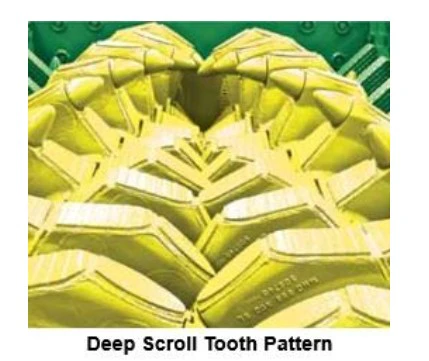
If provided, a deep scroll tooth pattern/configuration helps in spreading the feed material evenly over the whole width of the crushing rolls. This is important in order to achieve high throughput capacities. Furthermore, uniform wear attained in the feeding area results in a longer lifetime of the wear parts.
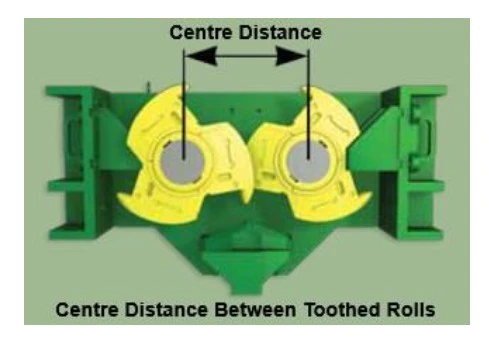
The centre distance between toothed rolls combined with the tooth configuration controls the maximum size of infeed material that the unit can process efficiently. The length of the inlet has a major effect on the volume of material that the unit can process.
To handle sticky materials, the low speed sizers can be provided with scraper bars that are located between the rows of sizing teeth to keep the toothed shafts clean at all times.
Maintenance
Routine maintenance requirements are minimal. Periodically check tightness of frame, tooth and liner bolts. Check wear and adjust breaker plates or replace breaking elements (teeth and breaker plates) as per requirement. Carry out lubrication as per manufacturers recommendations.

